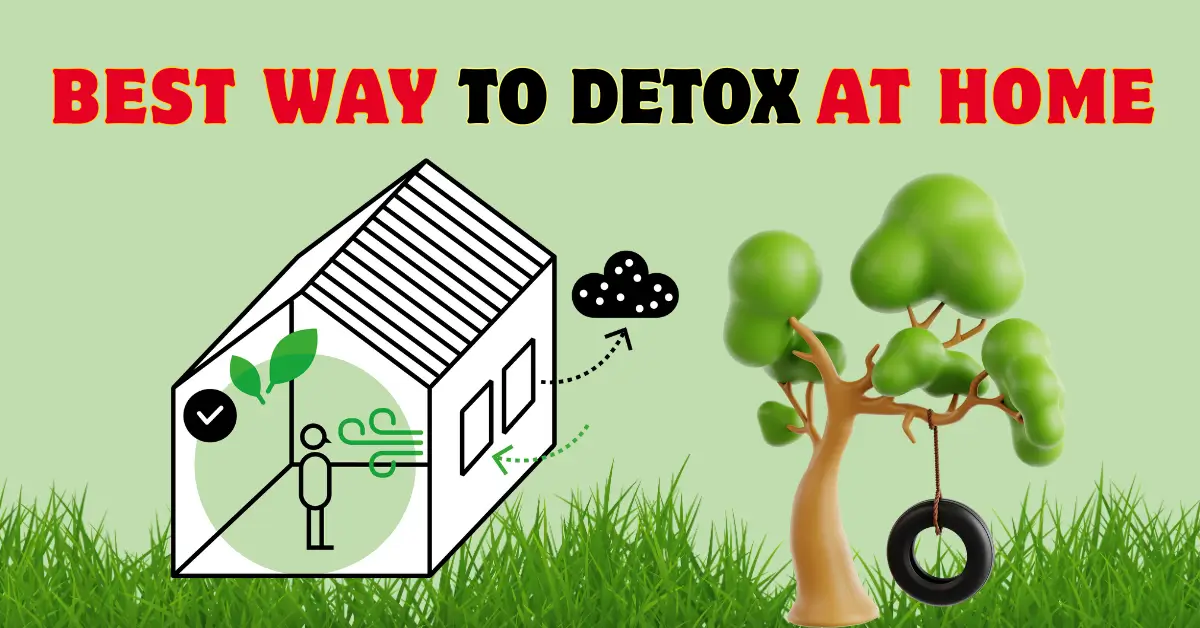Looking for the best way to detox at home? Learn how to remove toxic chemicals, improve indoor air quality, and build a safe, eco-friendly home with simple daily steps.
Thank you for reading this post, don't forget to subscribe!Finding the best way to detox at home isn’t about expensive gadgets or complicated routines. It’s about making simple, smart choices that protect your health every day.
From improving indoor air quality to replacing toxic products with safer alternatives, home detoxing helps you breathe easier, sleep better, and feel more energized. With the right steps, your living space can transform into a true sanctuary for wellness.
The Hidden Dangers in Your Home & Best Way to Detox at Home
Your home feels safe. It’s your personal sanctuary. But what if I told you that the air inside your house could be more polluted than the air outside? Studies show that indoor air quality often carries two to five times more toxins than outdoor air. From cleaning products to furniture, hidden chemicals sneak into your daily life without you even noticing.

These toxins build up in dust, fabrics, and even the water you drink. Over time, they affect your breathing, energy, sleep, and overall health. A home that should protect you can quietly harm you. That’s why learning the best way to detox at home is not a luxury—it’s a necessity.
How to Find the Best Way to Detox at Home and Protect Your Health
This guide will help you recognize the most dangerous household toxins and provide a straightforward plan for transforming your living environment. You will find the best way to detox at home. Let’s begin by identifying the sources you need to watch for before moving on to actionable solutions.
Section 1: Identifying the Common Culprits (The What)
Detoxing your home starts with awareness. You can’t remove toxins if you don’t know what they are. Here are the most common pollutants hiding indoors.
VOCs and Indoor Air Pollution
Volatile Organic Compounds (VOCs) are invisible gases released from common household items. VOCs are chemicals that easily become vapors or gases at room temperature. You’ll find them in paints, varnishes, new carpets, cleaning sprays, and even air fresheners.
When you inhale VOCs daily, you may notice headaches, dizziness, or fatigue. Long-term exposure is linked to liver damage, nervous system issues, and chronic respiratory conditions.
Formaldehyde in Household Products
Formaldehyde lurks in particleboard, pressed wood furniture, adhesives, and some fabrics. Formaldehyde is a colorless, strong-smelling chemical used to make building materials.
That “new furniture smell” is often formaldehyde. Breathing it can irritate your eyes, nose, and throat. For sensitive people, it can trigger asthma attacks or allergic reactions. Over the years, exposure may even raise cancer risk.
Phthalates and BPA in Plastics
Plastics often contain harmful chemicals like phthalates and Bisphenol A (BPA). Phthalates are chemicals used to make plastics flexible, and BPA is a chemical that makes plastic hard and clear.
These substances are found in vinyl flooring, shower curtains, food storage containers, and even children’s toys. They interfere with hormones and may cause reproductive issues, weight gain, and metabolic problems. If you microwave food in plastic, you increase your exposure dramatically.
Mold and Mildew Exposure
Mold thrives in damp, poorly ventilated spaces like bathrooms, kitchens, and basements. It spreads quickly, releasing spores into the air. Breathing mold spores can trigger allergies, chronic coughing, sinus infections, and even skin irritation. Black mold in particular is a serious health hazard.
Pesticides and Outdoor Chemicals Indoors
Every time you walk into your house with shoes on, you carry pesticides, herbicides, and heavy metals from outside. Pets bring them in on their paws, too. These chemicals collect on floors, carpets, and furniture. Long-term exposure is linked to neurological problems, hormonal disruption, and even developmental delays in children.
Section 2: The Action Plan for a Non-Toxic Home (The How)
Now that you know the threats, it’s time to act. Detoxing your home doesn’t mean spending thousands on new products. Small, practical steps can dramatically reduce toxic exposure.

Part A: Purify Your Air
Ventilation is Key
Fresh air is your best detox tool. Open your windows for at least 10 minutes daily, even in winter. Cross-ventilation—opening windows on opposite sides—creates natural airflow. Always run exhaust fans in bathrooms and kitchens to push toxins out.
Air-Purifying Plants
Houseplants don’t just look pretty. NASA studies found that some plants absorb toxins like benzene, formaldehyde, and trichloroethylene. Benzene is a chemical found in some plastics and dyes, while trichloroethylene is used in adhesives and cleaners. Add snake plants, spider plants, or peace lilies to your living room and bedroom. They’re natural, affordable air purifiers that also boost mood and oxygen levels.
Invest in a HEPA Filter
A HEPA filter removes microscopic particles, allergens, and airborne toxins. HEPA stands for High-Efficiency Particulate Air, meaning it’s designed to trap tiny pollutants from the air.
Place one in your bedroom and living area, where you spend the most time. Unlike regular filters, HEPA filters capture dust mites, mold spores, and even pet dander.
Avoid Synthetic Scents
Many candles, sprays, and plug-in air fresheners release toxic chemicals. Instead, switch to beeswax candles, essential oil diffusers, or simmered herbs like cinnamon and cloves. Your home will smell inviting without harming your lungs.
Part B: Green Cleaning and Maintenance the Best Way to Detox at Home
DIY Non-Toxic Cleaners
Commercial cleaners often contain harsh chemicals. You can make your own powerful cleaners with simple ingredients.
- All-purpose cleaner: Mix equal parts water and vinegar, and add lemon juice for freshness.
- Scrub: Use baking soda with water to clean sinks, bathtubs, and ovens.
- Glass cleaner: Mix water, vinegar, and a few drops of rubbing alcohol.
These solutions are safe, affordable, and eco-friendly.
Switch to Eco-Friendly Products
If DIY isn’t your style, buy eco-certified cleaning brands. Look for labels that say “non-toxic,” “biodegradable,” or “fragrance-free.”
Adopt a “No Shoes Indoors” Rule
Adopting a ‘No Shoe Indoors is a single habit that reduces a huge amount of toxins indoors. Provide slippers or socks for family and guests. It also keeps your home cleaner with less effort.
Dusting and Vacuuming the Right Way
Dust contains toxic chemicals, flame retardants, and heavy metals. Wipe surfaces with a damp cloth instead of a dry duster to trap particles. Vacuum twice a week with a HEPA filter vacuum to remove fine dust and allergens.
Part C: Upgrade Your Materials
Safer Kitchen Swaps

Plastic leaches chemicals into your food, especially when heated. Replace plastic storage containers with glass or stainless steel. Switch from non-stick pans, which release toxic fumes, to cast iron or ceramic cookware. These last longer and are safer for cooking.
Mindful Furniture and Decor
Choose low-VOC paints and solid wood furniture. If you can, invest in an organic mattress made of natural latex or cotton. Fabrics like organic wool and hemp are better than synthetic blends that emit VOCs.
Water Filtration for Better Health
Tap water may contain chlorine, heavy metals, pesticides, and even microplastics. Microplastics are tiny plastic pieces less than five millimeters long, often too small to see. A water filter can remove many of these toxins. Start with a simple activated carbon filter, or go for a reverse osmosis system for more profound purification.
Section 3: Long-Term Strategies and Lifestyle Changes
Detoxing your home isn’t a one-time project—it’s a lifestyle. Here’s how to keep your progress going.

Build Sustainable Habits
Consistency matters more than perfection. Small actions, like opening windows, dusting, or choosing non-toxic products, build up over time.
Read Labels Like a Pro
Always check product labels. Look for BPA-free, organic, eco-certified, and low-VOC markings. If a product lists “fragrance” without details, it likely hides harmful chemicals.
DIY as a Lifestyle
Making your own products gives you control. From cleaners to skincare, DIY ensures you know exactly what goes into your home. Plus, it reduces plastic waste and saves money.
Conclusion on Finding the Best Way to Detox at Home
Your home should be your safe space, not a hidden source of toxins. By learning about VOCs, formaldehyde, plastics, mold, and pesticides, you now know what to avoid. By improving indoor air quality, cleaning with natural solutions, and choosing safer materials, you protect your health every single day.
- The benefits are enormous: better sleep, fewer allergies, more energy, and peace of mind. A detoxed home doesn’t just protect your body—it lifts your mood and makes your living space truly nourishing.
- Start small today: swap one plastic container for glass, open your windows daily, or purchase a non-toxic cleaner this week. Take action now—every change makes a difference. Build your green, chemical-free home step by step, strengthening your health and the planet’s future.
Begin your journey now—commit to a cleaner, safer, and more vibrant life at home. Take your first step today and witness the change. And get the best way to detox at home.
Read more articles and Health & Wealth Tips.
You might like:

